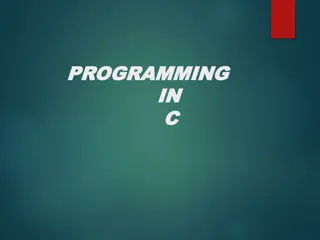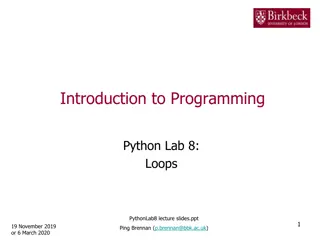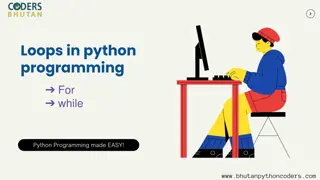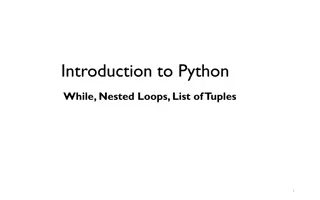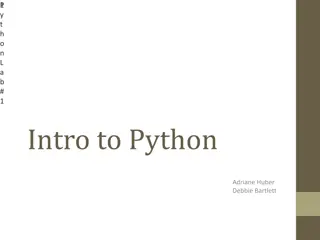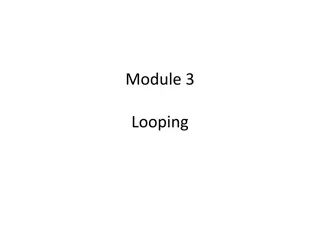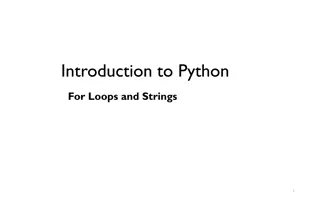Python Loops and Control Flow
This content delves into the concept of loops and control flow in Python programming, discussing the benefits of utilizing conditionals and loops to manage the sequence of statements. It covers the motivations behind using loops, introduces the while loop, and includes visual aids such as flowcharts and tracing examples. Learning about loops is crucial for optimizing code efficiency and reducing redundancy in programming tasks.
Download Presentation

Please find below an Image/Link to download the presentation.
The content on the website is provided AS IS for your information and personal use only. It may not be sold, licensed, or shared on other websites without obtaining consent from the author.If you encounter any issues during the download, it is possible that the publisher has removed the file from their server.
You are allowed to download the files provided on this website for personal or commercial use, subject to the condition that they are used lawfully. All files are the property of their respective owners.
The content on the website is provided AS IS for your information and personal use only. It may not be sold, licensed, or shared on other websites without obtaining consent from the author.
E N D
Presentation Transcript
CHAPTER 5 LOOPS ACKNOWLEDGEMENT: THESE SLIDES ARE ADAPTED FROM SLIDES PROVIDED WITH INTRODUCTION TO PROGRAMMING USING PYTHON, LIANG (PEARSON 2013)
CONTROL FLOW Control flow. Sequence of statements that are actually executed in a program. Conditionals and loops: enable us to choreograph control flow. boolean 1 statement 1 true false statement 2 statement 1 true boolean 2 statement 2 statement 3 false statement 4 statement 3 straight-line control flow control flow with conditionals and loops
MOTIVATIONS Suppose that you need to print a string (e.g., "Welcome to Python!") a hundred times. It would be tedious to have to write the following statement a hundred times: print("Welcome to Python!") So, how do you solve this problem? How about altering our guessing game program to allow 20 tries?
OPENING PROBLEM print("Welcome to Python!") print("Welcome to Python!") print("Welcome to Python!") print("Welcome to Python!") print("Welcome to Python!") print("Welcome to Python!") print("Welcome to Python!") print("Welcome to Python!") 100 times
INTRODUCING WHILE LOOPS 1. count = 0 2. while count < 100: 3.print("Welcome to Python") 4. count += 1
WHILE LOOP FLOW CHART 1. 2. 3. 1. 2. 3. 4. whileloop-continuation-condition: # loop-body Statement(s) count = 0 while count < 100: print("Welcome to Python") count += 1 count = 0 False count < 100? True print("Welcome to Python!") count += 1
TRACING WHILE LOOPS 1. count = 0 2. while count < 2: 3.print("Welcome to Python") 4. count += 1 Memory Output
TRACING WHILE LOOPS 1. count = 0 2. while count < 2: 3.print("Welcome to Python") 4. count += 1 Initialize Count Memory count: 0 Output
TRACING WHILE LOOPS 1. count = 0 2. while count < 2: 3.print("Welcome to Python") 4. count += 1 Count < 2 is true Memory count: 0 Output
TRACING WHILE LOOPS 1. count = 0 2. while count < 2: 3.print("Welcome to Python") 4. count += 1 Output Memory count: 0 Output Welcome to Python
TRACING WHILE LOOPS 1. count = 0 2. while count < 2: 3.print("Welcome to Python") 4. count += 1 Increment count Memory count: 0 1 Output Welcome to Python
TRACING WHILE LOOPS 1. count = 0 2. while count < 2: 3.print("Welcome to Python") 4. count += 1 Count < 2 is true Memory count: 0 1 Output Welcome to Python
TRACING WHILE LOOPS 1. count = 0 2. while count < 2: 3.print("Welcome to Python") 4. count += 1 Output Memory count: 0 1 Output Welcome to Python Welcome to Python
TRACING WHILE LOOPS 1. count = 0 2. while count < 2: 3.print("Welcome to Python") 4. count += 1 Increment count Memory count: 0 1 Output Welcome to Python Welcome to Python 2
TRACING WHILE LOOPS 1. count = 0 2. while count < 2: 3.print("Welcome to Python") 4. count += 1 Count < 2 is false Memory count: 0 1 Output Welcome to Python Welcome to Python 2
TRACING WHILE LOOPS 1. count = 0 2. while count < 2: 3.print("Welcome to Python") 4. count += 1 Continue after Memory count: 0 1 Output Welcome to Python Welcome to Python 2
EXAMPLES WITH A PARTNER What are the values of ? and ? after this program: n = 1234567 m = 0 while n != 0: m = (10*m) + (n % 10) n //= 10 Show the trace of the program at each step
QUESTION What is wrong with the following code? What happens? Fix it and explain what the code outputs 1. 2. 3. 4. i, N = 0, 10000 while i <= N: print(i) i = i + 5
ACTIVITY Write an algorithm to compute the number of digits an integer has. Example: input 34567 output 5 Bonus: modify your algorithm to compute the number of digits that the number would have if converted to another base, e.g., binary, octal, or hexadecimal
CAUTION Don t use floating-point values for equality checking in a loop control. Since floating-point values are approximations for some values, using them could result in imprecise counter values and inaccurate results. Consider the following code for computing 1 + 0.9 + 0.8 + ... + 0.1: 1. item, sum = 1, 0 2. while item != 0: # No guarantee item will be 0 3. sum += item 4. item -= 0.1 5. print(sum)
FOR LOOPS 1. 2. 3. forvarinsequence: # loop body Statement(s) Initialize var to first element Try to update var to be the next element in the sequence Example 1. 2. Have all elements in sequence been visited? for x inrange(0, 100): print("Welcome to Python!") True False Statement(s) Here "end" refers to 1 after the last element of the sequence.
TRACING FOR LOOPS 1. for x inrange(0, 2): 2.print("Welcome to Python!") Memory Output
TRACING FOR LOOPS 1. for x inrange(0, 2): 2.print("Welcome to Python!") Initialize x Memory x: 0 Output *Note* range(0, 2) is [0, 1]
TRACING FOR LOOPS 1. for x inrange(0, 2): 2.print("Welcome to Python!") Have all elements been visited? No Memory x: 0 Output *Note* range(0, 2) is [0, 1]
TRACING FOR LOOPS 1. for x inrange(0, 2): 2.print("Welcome to Python!") Output Memory x: 0 Output Welcome to Python! *Note* range(0, 2) is [0, 1]
TRACING FOR LOOPS 1. for x inrange(0, 2): 2.print("Welcome to Python!") Try to set x to next element of sequence Memory x: 0 1 Output Welcome to Python! *Note* range(0, 2) is [0, 1]
TRACING FOR LOOPS 1. for x inrange(0, 2): 2.print("Welcome to Python!") Have all elements been visited? No Memory x: 0 1 Output Welcome to Python! *Note* range(0, 2) is [0, 1]
TRACING FOR LOOPS 1. for x inrange(0, 2): 2.print("Welcome to Python!") Output Memory x: 0 1 Output Welcome to Python! Welcome to Python! *Note* range(0, 2) is [0, 1]
TRACING FOR LOOPS 1. for x inrange(0, 2): 2.print("Welcome to Python!") Try to set x to next element of sequence Memory x: 0 1 Output Welcome to Python! Welcome to Python! *Note* range(0, 2) is [0, 1]
TRACING FOR LOOPS 1. for x inrange(0, 2): 2.print("Welcome to Python!") Have all elements been visited? Yes Memory x: 0 1 Output Welcome to Python! Welcome to Python! *Note* range(0, 2) is [0, 1]
TRACING FOR LOOPS 1. for x inrange(0, 2): 2.print("Welcome to Python!") Continue after Memory x: 0 1 Output Welcome to Python! Welcome to Python! *Note* range(0, 2) is [0, 1]
RANGE Range is a method that generates a sequence of integer numbers range(a, b, step) generates numbers from a up to but not including b with an increment of step, e.g., range(2, 10, 2) returns 2,4,6,8 range(a, b) generates numbers from a up to but not including b with an increment of 1, e.g., range(1, 5) returns 1,2,3,4 range(b) generates numbers between 0 and b with an increment of 1, e.g., range(3) returns 0,1,2
PRACTICE Group 1: Write a for loop to output all numbers between integers ? and ? Group 2: Write a for loop to output the multiples of an integer ? up to ? Group 3: Write a for loop to output all the even numbers from 100 to 999 in reverse order.
COMPARE FOR LOOPS TO WHILE LOOP 1. 2. 3. 4. 1. 2. count = 0 while count < 100: print("Welcome to Python") count += 1 for x inrange(1, 100): print("Welcome to Python!") Note, each has their own use. For loops are a special case in which each element of a sequence is visited. In this case (and only this case) are for-loops appropriate in Python.
NESTING In control flow, nesting is where you place a control structure inside of another Example: 2 for loops to print a multiplication table 1. 2. 3. for i inrange(0, 10): for j inrange(0, 10): print(str(i) + "*" + str(j) + " = " + format(i*j, "2d"), end=" ") print() # Print a new line 4.
EXERCISE FIX THE GUESSING GAME Lets fix our guessing game program to allow up to 20 guesses. Additionally, try to protect against bad input Program this together If you get lost program is on following slides (split into multiple slides)
EXERCISE WHERE TO BEGIN When developing programs Always think first! Sketch out solution, i.e., plan Implement solution Test solution Repeat! Called iterative development Test Plan Implement
EXERCISE FIX THE GUESSING GAME 12. 13. 14. 15. 16. 17. 18. 19. 20. 21. 22. 23. 24. 1. 2. 3. 4. 5. 6. 7. 8. 9. 10. import random # Grab a random number rn = random.randint(1, 99) un = 0 guesses = 0 # Allow user to continually guess while rn != un and guesses < 20: un = int(input("Please enter a number between 1 and 99: ")) if un < 1 or un > 99: print("Invalid guess.") elif un == rn: print("You won!") elif un > rn: print("Too high") guesses += 1 else: # un < rn print("Too low") guesses += 1 if guesses == 20: print("You lost. Out of guesses. The correct number is " + str(rn) + ".") 11.
GAMBLER'S RUIN Gambler's ruin. Gambler starts with $stake and places $1 fair bets until going broke or reaching $goal. What are the chances of winning? How many bets will it take? One approach. Monte Carlo simulation. Flip digital coins and see what happens. Repeat and compute statistics.
GAMBLER'S RUIN 1. 2. 3. 4. 5. 6. 7. 8. 9. 10. 11. 12. 13. 14. 15. 16. import random stake, goal, T = eval(input("Enter stakes, goal, and T: ")) wins = 0 for t in range(T): cash = stake while cash > 0 and cash < goal: if random.random() < 0.5: cash += 1 else: cash -= 1 if cash == goal: wins += 1 print(wins, "wins of", T) % python3 Gambler.py 5 25 1000 191 wins of 1000 % python3 Gambler.py 5 25 1000 203 wins of 1000 % python3 Gambler 500 2500 1000 197 wins of 1000
OTHER HELPFUL STATEMENTS FOR LOOPS break immediately exit the loop. Do not continue executing any more of the loop. Example: while True: if q-key-is-pressed(): # quit the game break Game-loop() continue immediately skip to the end of the body of the loop, i.e., start next iteration. Example: for i inrange(0, 10): if(isPrime(i)) # OCD against prime numbers continue HandleNotPrimes()
CONTROL FLOW SUMMARY Control flow. Sequence of statements that are actually executed in a program. Conditionals and loops: enable us to choreograph the control flow. Control Flow Description Examples Straight-line programs All statements are executed in the order given if; if-else Conditionals Certain statements are executed depending on the values of certain variables while; for Loops Certain statements are executed repeatedly until certain conditions are met
EXERCISE Write a program to draw a checkerboard pattern with Turtle (either a Checker's board or a Chess board) You can set the speed of the turtle to infinity (turtle.speed(0)) Turtle allows the ability to draw a filled rectangle with turtle.begin_fill() and turtle.end_fill()


